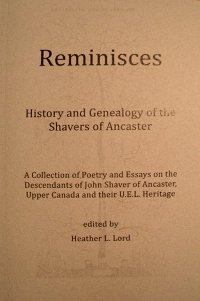 The Shavers of Ancaster and the War of 1812, Part 8
The Shavers of Ancaster and the War of 1812, Part 8
Guest Blog by Fred Blair
War Loss Claims
There were other documents which revealed more about life during the war and the lasting effects it had on the Upper Canadians. This Blog is about the War Loss Claims.
Inhabitants could claim for war losses during and after the war. The first claims commission was held on March 25, 1813. After the war claims were sorted by losses to the enemy, losses to the British military, and losses to allied Indians. About 1816 and later, claims were submitted to the commission for enemy losses or the commission for losses to the British military and their Indian allies but some claims were presented to the wrong commission and filed with those records. There was no money to pay claims after the war and claims had to be resubmitted in 1824 and later for payment. Some papers were filed in the wrong claim and there was a file of additional certifications that had been separated from the relevant claims. There are registers buried in the microfilm files but they are incomplete and contained errors. I have compiled an index of the names of the claimants with their place of residence at the time of the claim but I am still in the process of indexing it to the microfilm and page number for each claim and adding additional names relevant to each claim. My ancestor, Ebenezer Blair, was not in the registers because he did not make a war loss claim but he did write a certificate supporting his employer’s claim.
Henry and William Shaver of Ancaster Township and a William Rymal of Barton Township all made war loss claims. Enquiries about other claimants are welcome.
Thousands of Upper Canadians suffered the loss of their property during the war. As well as supplies, some lost their source of employment and their homes and farms. Some were forced to leave their property behind as they fled the hazards of living in a war zone. Most of those who lost property in 1812 had to wait at least four years for compensation only to discover that they had to wait another eight years for payment. For many Upper Canadians the ravages of the war lasted long after peace was declared in 1815.
On September 16, 1815, Henry Shaver made a war claim as a resident of Ancaster Township for a sleigh which was impressed by the British in the winter of 1814 and not returned to him. Frederick Vanderlip of Ancaster Township certified the claim. On January 31, 1824, Henry resubmitted his claim as a yeoman of Ancaster Township and reported that Frederick Vanderlip had since passed away (pages 1026-1032).
http://www.collectionscanada.gc.ca/microform-digitization/006003-119.01-...
On September 16, 1815, William Shafer of Ancaster Township made a war claim for losses to British troops and Indians. In 1813, he had seven acres of buckwheat destroyed by horses and lost a hog and four bee hives. In the fall of 1814 he lost another hog. In the winter of 1815 he lost two sheep. Henry Shafer of Ancaster Township certified the claim (pages 789-794).
http://www.collectionscanada.gc.ca/microform-digitization/006003-119.01-...
The same date and place of residence on these two claims and the fact that Henry certified William’s claim indicated that these men were closely related. They must have been the sons of John William Shaver.
On September 13, 1815, a William Rymal made a war claim as a resident of Barton Township for losses to British troops and Indians. In the spring of 1814, Indians took two large hogs, in July, two more hogs, and in February, 1815, a large boar. In the fall of 1814, he lost three bee hives and a large hog. Frederick Young certified the claim.
On April 15, 1825, William resubmitted his war claim as a resident of Barton Township for his horse which died while hauling stores from Burlington Heights to Detroit in 1813, hogs stolen, two shoats taken by British troops, and three bee hives. Christian Almas of Ancaster Township certified the claim. Frederick Young, a yeoman of Ancaster Township, was deceased (pages 582-591).
http://www.collectionscanada.gc.ca/microform-digitization/006003-119.01-...
On the same day he made a second war claim for the Union Mill Company for losses to Indians in the fall of 1813. He lost fifty chestnut trees and over two thousand rails. James Wilson of Ancaster Township certified the claim (pages 40-43).
http://www.collectionscanada.gc.ca/microform-digitization/006003-119.01-...
William Rymal of Barton Township had a connection to Ancaster Township because the men who certified his claims lived there. Was he Margaret Shavers husband?
There were over one hundred war loss claims documents filed by the residents of Ancaster Township alone. Many of these claims were made for losses to allied Indians. Major General Isaac Brock had called upon the Indians to help defend Upper Canada. Many responded in 1812 and travelled to the Niagara Frontier. They had to be housed and fed as any supplies that they brought with them would not last long. Where could Brock find cleared land for them to encamp? They were placed on farms where they could build their encampments, cut wood from woodlots, burn fence rails and orchards for fire wood, graze their horses in fields of grain, and when food supplies were scarce, help themselves to livestock and crops. The British military at times found themselves in the same position and impressed and stole supplies as well. In 1813, after the death of Tecumseth, many Indians fled west to the Hamilton area and joined the Indians already encamped there. Some Upper Canadians suffered heavy losses and had to abandon their farms and seek an income elsewhere.
The next Blog will be on Militia Land Grants and other grants which revealed more about the Shaver families.
Fred Blair
fredblairorillia@hotmail.com

